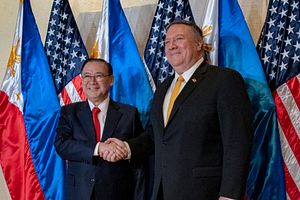Following the disappointing U.S.-North Korea summit meeting in Hanoi, which ended without any notable result, U.S. Secretary of State Mike Pompeo jetted off to Manila, where he offered a long-sought assurance to a U.S. treaty ally.
On Friday, Pompeo met with his Filipino counterpart Foreign Secretary Teddy Locsin and offered an assurance on the conditions under which the U.S.-Philippine Mutual Defense Treaty of 1951’s provisions on collective defense would apply.
“China’s island building and military activities in the South China Sea threaten [Philippine] sovereignty, security and therefore economic livelihood, as well as that of the United States,” Pompeo said.
“As the South China Sea is part of the Pacific, any armed attack on Philippine forces, aircraft or public vessels in the South China Sea will trigger mutual defense obligations under Article 4 of our mutual defense treaty,” Pompeo added.
That assurance had never before been offered to the Philippines, which had grown concerned over the applicability of the bilateral alliance treaty as tensions in the South China Sea between Manila and China, one of the other five claimants, heated up.
Pompeo’s visit to Manila came after the Philippine government had called to review the Mutual Defense Treaty. According to Philippine Secretary of National Defense Delfin Lorenzana in December 2018, the options under consideration after a review could include a decision to “maintain it, strengthen it, or scrap it.”
The Philippines is one of four U.S. treaty allies in Asia covered by collective defense arrangements; the other three are South Korea, Japan, and Thailand. Unlike South Korea and Japan, the Philippines does not host U.S. military personnel on a permanent basis.
A 2014 agreement concluded by the Obama administration won the United States the right to construct facilities and rotationally position and deploy defense-related equipment at a shortlist of military sites in the country.
In 2018, former U.S. Secretary of Defense Jim Mattis was asked at the Shangri-La Dialogue in Singapore whether the Mutual Defense Treaty would cover Philippine-occupied features in the South China Sea and Filipino vessels.
Mattis answered, noting that regarding “these matters,” American “public figures do not want to give specific answers,” because these are “complex issues.”
“We stand by our treaty allies, but this is a discussion between the current administrations in Manila and in Washington DC, and it is not one that can be answered as simply as your question would indicate,” Mattis added at the time.
In 2014, during a visit to the Philippines, former U.S. President Barack Obama was asked by local press to clarify if features in the South China Sea occupied by the Philippines and Philippine Navy vessels would be covered by the Mutual Defense Treaty. Obama did not offer a clear answer at the time, too.

































